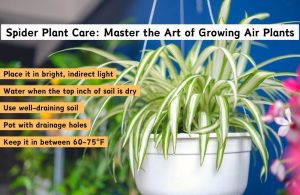This article covers the following areas –
- Getting to Know Philodendrons
- Caring for Your Philodendron: Simple Steps
- Troubleshooting Common Problems
- Final Thoughts

As someone who has nurtured a variety of houseplants over the years, I’ve always held a soft spot for philodendrons. Their charming leaves, ranging from heart-shaped to split, can easily elevate the ambiance of any room. However, like all plants, they come with their own set of needs. With some personal experience and research under my belt, I’d like to share some straightforward tips to help your philodendron thrive.
Philodendrons, tropical flora native to rainforests, thrive in bright indirect light, well-draining soil, and moderate humidity. Overwatering leads to yellowing leaves, while brown leaf tips indicate low humidity. These plants favor temperatures between 65°F and 80°F (18°C to 27°C).
Dive deeper into our comprehensive guide on Philodendron care. Uncover nuanced insights, practical tips, and troubleshooting solutions that cater to both the novice and seasoned plant enthusiast. From understanding their origin to decoding their distress signals, embark on this enlightening botanical journey.
Getting to Know Philodendrons
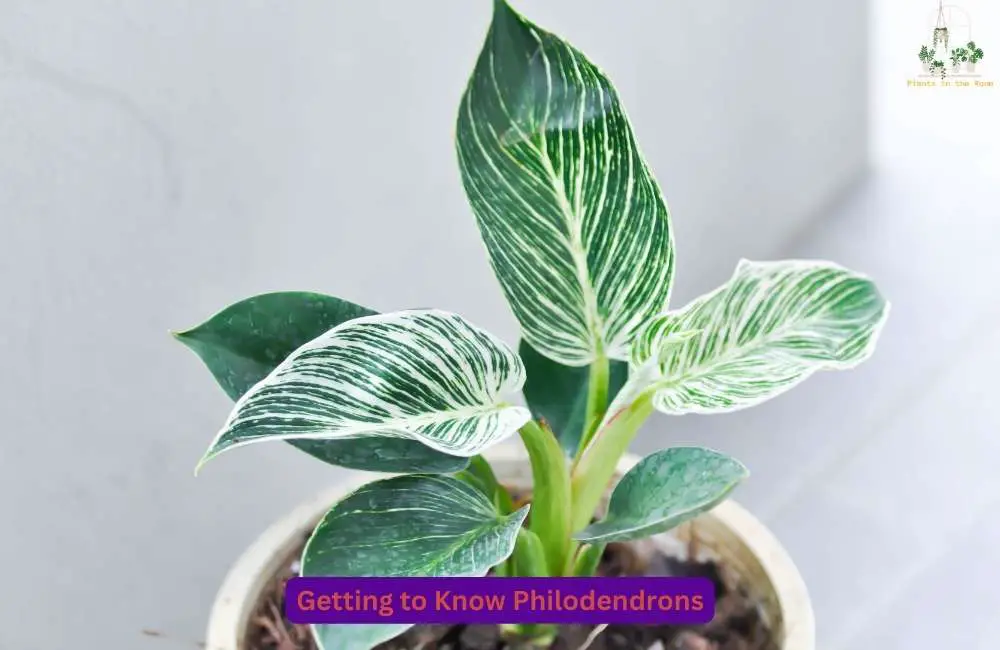
Philodendrons belong to the Araceae family, which encompasses numerous plants, many of which are popular in households due to their resilience and attractive foliage. But what distinguishes philodendrons from other houseplants is their versatility and distinctive growth patterns, predominantly classified into climbing and non-climbing varieties.
Climbing vs. Non-Climbing Varieties
Not all plants are created equal, and within the philodendron family, this is particularly evident. Diverse in their growth habits, philodendrons can be broadly categorized into climbers and non-climbers. Each type presents a unique appeal, so let’s dive deeper into these categories to understand their distinct characteristics.
Climbing Varieties
Imagine tendrils spiraling up a moss pole or gracefully trailing off a bookshelf, and you’re picturing the climbing philodendron. These varieties inherently desire to ascend, making them perfect for vertical spaces.
With its heart-shaped leaves, the heartleaf philodendron is a quintessential climber that can easily wrap around supports or cascade down containers.
Non-Climbing Varieties
Not all philodendrons seek heights. Some prefer to spread outwards, creating a lush, bushy appearance. They’re the centerpiece plants, drawing attention with their broad, often intricately patterned leaves.
The split-leaf philodendron, or Monstera deliciosa, although often mistaken as a different species, is a philodendron that showcases large fenestrated leaves, making it a showstopper in any room.
The Richness of Foliage: Patterns and Colors
Beyond their growth habits, philodendrons captivate with their leaves – the show’s true stars. This foliage varies widely, from plain greens to mesmerizing variegations. Let’s delve into this tapestry of colors and patterns, understanding the beauty each type brings to the table.
Solid Green Varieties
These classics offer a lush green hue that can complement any interior decor. Philodendron erubescens, with its deep green leaves, is a popular choice among enthusiasts.
Variegated Varieties
With streaks, spots, or splashes of white, yellow, or even pink, these philodendrons are truly a visual treat. The Philodendron ‘Pink Princess’ is a sought-after variety, boasting dark leaves splashed with bright pink.
Origin and Natural Habitat
A plant’s natural habitat provides vital clues about its care preferences. By tracing the philodendron’s roots to its native environment, we can emulate conditions conducive for its growth at home. Let’s journey to the rainforests where these plants originally hail from and discover their wild side.
Rainforest Origins
In the wild, climbing philodendrons often ascend trees, while non-climbing varieties spread out on the forest floor or in clearings. This behavior influences their light and humidity preferences in our homes.
With this foundational knowledge, you’re better equipped to care for and appreciate the philodendron in its entirety, ensuring it thrives in your indoor space.
Caring for Your Philodendron: Simple Steps
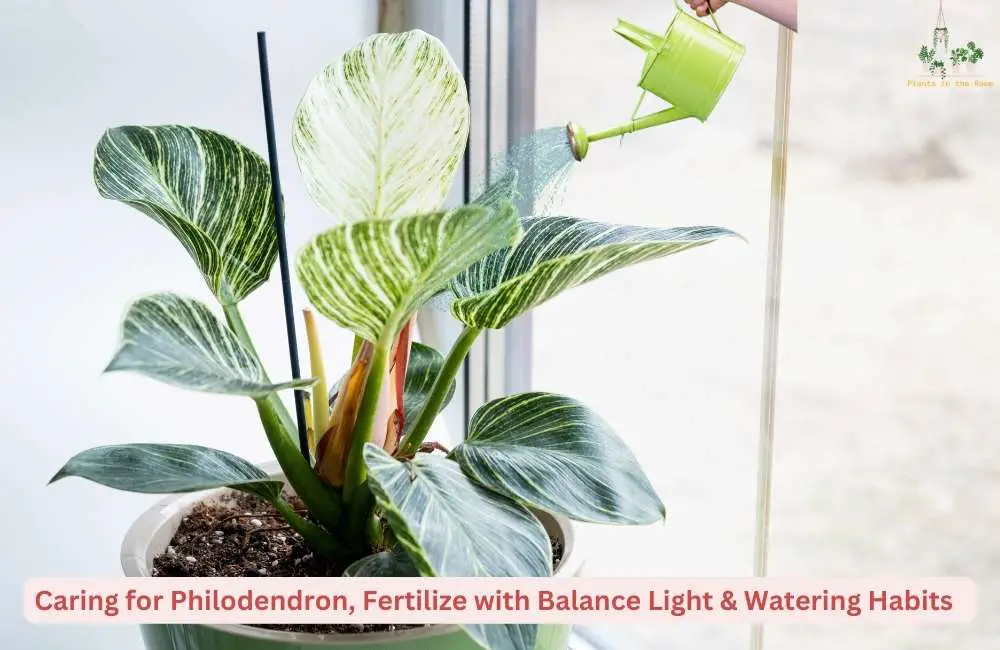
The philodendron’s allure lies in its tropical beauty and adaptability, effortlessly bringing nature’s serenity into our homes. But as with any plant, there’s an art to its care, rooted deeply in understanding its unique needs. Let’s delve into the world of philodendrons and uncover the lighting conditions they truly desire.
1. Light Requirements: Finding the Balance
Every plant has its relationship with light, and understanding this relationship is key to a thriving philodendron. Let’s decode its preferences.
Natural Habitat Insight
In the dense rainforests where philodendrons originate, they find refuge under the vast canopy of towering trees. This strategic positioning allows them to soak in filtered sunlight that trickles down, teaching us about their light preferences.
Optimal Light: The Gentle Glow
Bright, indirect sunlight is the way to a philodendron’s heart. Such light conditions emulate the dappled sunlight of their native environment. Observing your plant can provide clues: leaves stretching toward a light source signify a desire for more, while paler leaves might indicate an excess.
The Perils of Direct Sun
While sunlight is life-giving, too much of it can harm philodendrons, especially in its direct form. During intense afternoon hours, direct sunlight can leave your philodendron with yellow or scorched leaves, similar to how our skin reacts to sunburn.
Strategies for Low-light Conditions
Life doesn’t always bless us with homes bathed in sunlight. But worry not, for philodendrons are versatile. Though they may grow slower, and their green might be less vibrant in low light, they’ll still thrive.
Positioning them near windows draped with sheer curtains can mitigate low light. These curtains soften harsh rays, giving your plant a gentle luminescence. For an added touch, rotate your plant periodically, ensuring all its sides get a fair share of the light.
Armed with these insights, you can create a haven for your philodendron, allowing it to grace your space with its lush presence.
2. Watering Habits
Watering seems like the most straightforward aspect of plant care. Yet, it’s often where most of us falter out of over-enthusiasm or neglect. With their tropical origins, Philodendrons have specific hydration needs that, when met, contribute to their radiant health.
Understanding the Golden Rule
Every gardener, newbie, or veteran should etch this into their memory: Water when the top inch of soil feels dry. For philodendrons, this ensures the roots get just the right amount of moisture without being drenched. A simple finger test, inserting your finger up to an inch into the soil, can be a reliable guide. If it feels dry, it’s time to water; if still damp, give it a few more days.
The Importance of Drainage
The pot you choose is more than just a decorative element. It’s a vessel that should support the plant’s growth and health. A pot with good drainage prevents excess water from pooling at the bottom, which can be a precursor to the dreaded root rot. As the name suggests, root rot causes the roots to decay, often resulting from stagnant water.
Practical Tips: The Saucer Strategy
A simple yet effective tool, the saucer can be a plant parent’s best friend. Placing a saucer under your philodendron’s pot serves a dual purpose: it catches any excess water that drains out, preventing messes, and it also acts as a reservoir.
If the plant needs a little more moisture, it can absorb the water from the saucer. However, remember to empty the saucer if the water remains unabsorbed for too long, ensuring the plant doesn’t sit in stagnant water.
The key to philodendron watering is a blend of observation and understanding. When in tune with the plant’s moisture needs, you’re one step closer to ensuring its thriving existence in your care.
3. Soil and Fertilizer
Akin to how we humans need a stable home and nutritious food, plants too seek a reliable foundation and sustenance. Philodendrons, while fairly adaptable, have preferences when it comes to the type of soil they sit in and the nutrients they absorb. Let’s dive into the details of ensuring a robust base for these tropical beauties.
Selecting the Right Soil
The soil, often overlooked, is the silent nurturer of every plant. For philodendrons, their tropical origins have made them accustomed to well-aerated soils that allow roots to breathe while retaining just enough moisture.
- Soil Type: A general-purpose houseplant mix, known for its well-draining properties, aligns well with their needs. These mixes typically contain a blend of peat, pine bark, and perlite or sand, ensuring both moisture retention and drainage. If you’re feeling adventurous, you can even create your own mix by combining these elements!
Feeding for Growth: Fertilizer Essentials
As seasons change, so do a plant’s nutritional requirements. And while soil provides many vital nutrients, occasional supplementation can help philodendrons reach their full potential.
- Feeding Time: Spring and summer see philodendrons in their prime growth phase. During these months, a monthly application of balanced liquid houseplant fertilizer can offer the additional nutrients they crave. This not only supports new leaf growth but also bolsters the overall health and vibrancy of the plant.
Tips for Safe and Effective Fertilizing
Fertilizers, though beneficial, can be a double-edged sword. Over-enthusiastic fertilizing can lead to nutrient burn, where the plant’s roots absorb more than they can handle.
- Safety First: It’s crucial always to follow the dosage recommendations on the fertilizer packaging. If you’re ever in doubt, remember: it’s better to under-fertilize than overdo it. Too much of a good thing can stress the plant, leading to brown leaf tips or stunted growth.
Investing a bit of attention in the right soil mix and understanding the nuances of fertilizing ensures that your philodendron survives and thrives, rewarding you with its lush, tropical charm.
4. Temperature and Humidity
Every philodendron is a living testament to the balmy, humid rainforests from where they hail. Understanding these roots (both metaphorically and literally) provides invaluable insights into the temperature and humidity conditions they favor. By striving to replicate this environment, even if only to some degree, we can ensure our philodendrons flourish in our homes.
A Goldilocks Zone for Temperature
Much like us, philodendrons seek comfort. Too cold, and they recoil; they’re too hot and stressed.
- Temperature Sweet Spot: Nestling between 65°F and 80°F (18°C to 27°C), philodendrons find their optimal comfort. Keeping them within this range, especially avoiding sudden temperature drops, ensures their growth isn’t hampered.
Mimicking the Humidity of Home
In tropical rainforests, the air is thick with moisture, providing a constant source of hydration for the plants. While our homes might not have this inherent humidity, innovative ways exist to bridge the gap.
- Keeping It Moist: Several strategies can bump up the humidity for your philodendron. Humidifiers, widely available, can maintain a constant moisture level in the air. For a simpler solution, occasionally misting the leaves with water mimics the dewy rainforest mornings. And of course, plants are social creatures! Grouping them together can create a micro-environment of increased humidity, where every plant benefits from the collective moisture.
Group Dynamics: Harnessing Collective Humidity
An often overlooked trick in the plant world is the power of numbers. When grouped, plants release moisture, creating a localized humid environment.
- Community Benefits: Beyond just philodendrons, most tropical houseplants love humidity. So, placing them together enhances the aesthetic appeal of your plant corner and creates a beneficial atmosphere. It’s a win-win, both for the plant owner and the green companions.
In essence, temperature and humidity care is about tuning into the innate needs of the philodendron, born from its tropical lineage. With a bit of observation and creativity, even the driest apartments or homes can be transformed into a haven for these lush, leafy wonders.
5. Pruning and Maintenance
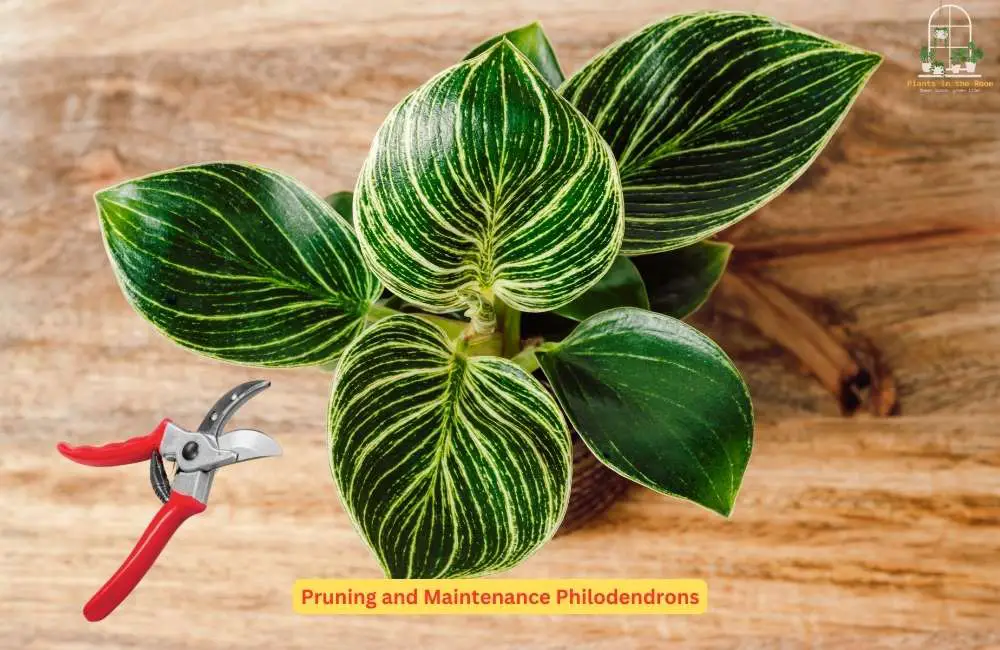
A bit of grooming and care ensures our philodendron remains as dazzling as the day you brought it home. Think of pruning as a spa day for your plant, where it gets refreshed, rejuvenated, and primed for healthier growth.
Regular Visual Inspections: Understanding Plant Language
Just as we show signs of distress or ill health, philodendrons communicate through their leaves. Regular check-ins allow us to decode these signals and act accordingly.
- Leaf Health: Yellow, brown, or damaged leaves are a cry for help. These leaves might be affected by a range of issues, from overwatering to pest attacks. Removing them enhances the plant’s aesthetic appeal and diverts energy to healthier growth.
Growth Control: Setting Boundaries
Philodendrons, especially the climbers, can sometimes get a little too enthusiastic in their growth spurt, venturing where they might not be welcome.
- Taming the Climbers: Some climbing philodendrons can swiftly take over your space if left unchecked. Occasional trims allow you to shape their growth, ensuring they accentuate your decor rather than dominate it. It’s also a great opportunity to propagate the cuttings and expand your plant family!
The Art of Pruning: Tips for Effective Trimming
Armed with the right tools and techniques, pruning becomes a stress-free, almost therapeutic activity.
- Clean Cuts: Always opt for sharp scissors or pruning shears. A clean, smooth cut reduces trauma to the plant and aids in quicker healing. Before and after each pruning session, cleaning the tools with isopropyl alcohol or a similar disinfectant ensures no pathogens harm your precious green companion.
Maintenance might seem like a chore on the surface, but it’s the cornerstone of a long, happy relationship with your philodendron. Regular attention ensures your plant remains vibrant, healthy, and an evergreen source of joy in your living space.
6. Pest Prevention

A thriving philodendron is a sight to behold, but occasionally, these luscious greens catch the eye of unwanted critters. Pests, while tiny, can wreak havoc if not addressed timely. But fear not, with proactive measures and vigilance, you can ensure your verdant friend stays pest-free.
The Art of Regular Checks: Knowing Where Pests Lurk
Observation is a powerful tool in pest prevention. By frequently checking, you become familiar with your plant’s natural state and can quickly identify anomalies.
- Undercover Culprits: Most pests have a knack for stealth. The undersides of leaves, stem joints, or even the soil can harbor these tiny invaders. Aphids, spider mites, and mealybugs are a few that have a penchant for philodendrons. A close inspection, especially underneath the leaves, can reveal their hideouts.
Immediate Action: Addressing the Uninvited
Spotting pests is half the battle won. The next step is ensuring they don’t overstay their welcome.
- Gentle Eviction: A gentle water spray can dislodge many pests if you find a minor infestation. For those more stubborn, an insecticidal soap or neem oil solution, available at gardening stores, acts as an effective, plant-friendly pesticide. Remember to follow the application instructions for the best results.
Prevention Over Cure: Ongoing Maintenance
Beyond just addressing a current pest issue, it’s equally vital to deter future invasions.
- Leaf TLC: Like dusting keeps our homes clean, wiping down your philodendron’s leaves keeps them pristine. A soft, damp cloth can remove dust and possible pests while giving the leaves a lustrous sheen. This dual action makes the plant more resilient against pests and enhances its aesthetic appeal.
In the world of philodendron care, pests might seem like formidable adversaries. Still, with consistent attention and a bit of knowledge, your plant can remain a tranquil, pest-free oasis, bringing you unbridled joy and tranquillity.
By heeding these simple steps and paying attention to your plant’s signals, you’ll foster a deep connection with your philodendron, ensuring it remains a vibrant addition to your home for years to come.
Troubleshooting Common Problems
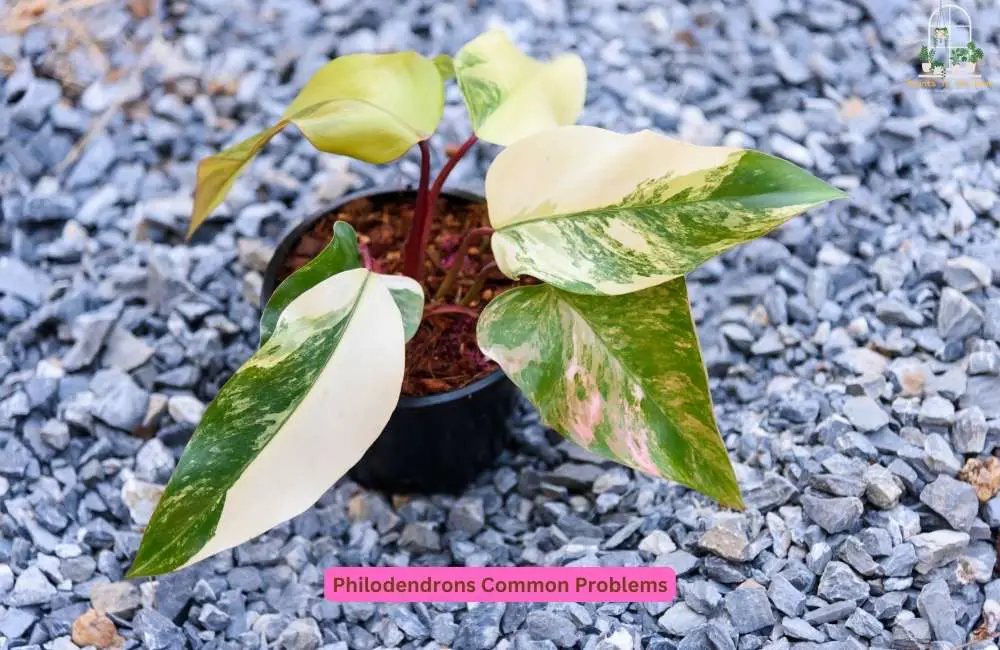
Every philodendron parent, whether a seasoned botanist or a green-thumbed newbie, will inevitably face moments when their leafy child shows signs of distress. Much like a baby’s cry or a pet’s whimper, these signals are the plant’s way of communicating its needs.
The trick lies in deciphering these cues correctly. This section will explore some of the most common issues philodendrons grapple with and how to address them, ensuring your plant remains a beacon of health and happiness.
Yellowing Leaves: The Overwatering Alarm
Yellowing leaves are the plant’s SOS signal. It’s a common sight, but understanding its root cause is vital.
The Telltale Signs
- Soft, Mushy Soil: If the soil feels wet and mushy for extended periods, it’s a clear sign of overwatering. Philodendrons prefer their soil to dry out a bit between waterings.
- Leaf Feel: The yellow leaves might also feel soft and limp instead of firm and turgid.
Solutions and Preventive Measures
- Check Drainage: If water isn’t escaping the pot, it’s time for some pot surgery. Ensure the pot has drainage holes. If not, consider repotting into one that does.
- Adjust Watering Schedule: Remember the golden rule; water when the top inch of soil feels dry. Less is often more.
Brown Leaf Tips: A Humidity Hint
Brown tips are like the philodendron’s way of saying, “I miss the tropical humidity!”
Diagnosing the Issue
- Room Environment: Dry, arid conditions, especially in winter when indoor heaters are running, can sap the moisture from the air.
- Leaf Appearance: The tips of the leaves might appear dry, crispy, and brown, contrasting with the otherwise green foliage.
Humidity to the Rescue
- Misting: A quick and simple remedy is gently misting the leaves with water. This replicates the dewy mornings of the rainforest and gives the plant a brief humidity boost.
- Humidifiers: For a more lasting solution, consider placing a humidifier in the room. It benefits the philodendron and other tropical plants (and even your skin!).
Droopy Leaves: A Thirsty Cry or Chilly Complaint?
When the normally perky leaves start drooping, it could be a sign of two things – either the plant is too thirsty or it’s feeling cold.
Checking for Thirst
- Soil Test: If the soil is bone dry to a considerable depth, your philodendron might need a drink.
Protecting from Cold
- Location: Ensure your plant isn’t near a drafty window or door. Cold drafts can shock the plant, leading to droopiness.
- Temperature Check: Remember the ideal temperature range of 65°F to 80°F (18°C to 27°C). Consider relocating the plant to a warmer spot if your home is cooler.
Navigating the maze of plant care might seem daunting initially, with every yellow leaf or brown tip sparking concern. However, armed with knowledge and a keen observational eye, these challenges transform into rewarding learning experiences, deepening the bond between you and your leafy companion.
Remember, every philodendron, like us, has unique quirks and needs. By tuning into these, we ensure they live their best, most verdant lives.
Final Thoughts
In the grand tapestry of the plant world, philodendrons stand out for their lush beauty and resilience. Their adaptability, combined with their captivating appearance, has cemented their place in countless homes and hearts.
However, like all living beings, they communicate their needs subtly. With this guide’s knowledge, caretakers can foster a nurturing environment, allowing their philodendrons to flourish.
Whether you’re a budding green thumb or a seasoned botanist, the journey with these tropical marvels promises to be one filled with growth, both of the plant and the nurturer. Here’s to verdant spaces and deeper connections with nature’s wonders.




